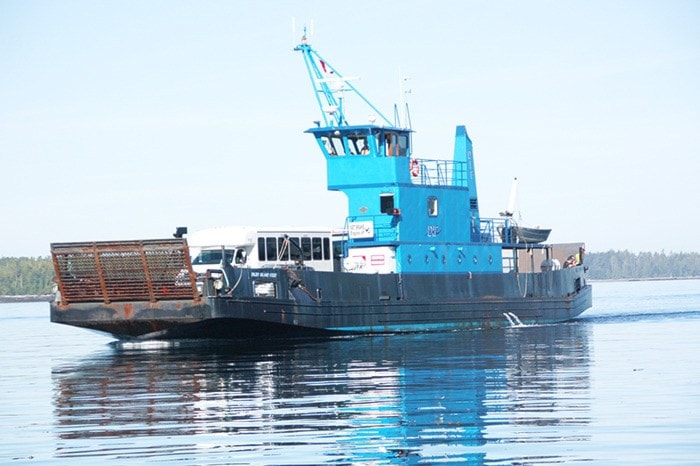Facing an infrastructure deficit nearing $300 million, the City of Prince Rupert will need to come up with an additional $14.5 million per year to support LNG-related operations according to a report prepared for city council by KPMG.
Status Quo
The report, entitled City of Prince Rupert Preparing for Growth, outlines some of the current infrastructure woes facing the city. To sustain current operations, without considering any LNG developments, the city estimates it will need $58 million for transportation-related items, $37.8 million for the water system, $163.6 million for the sewer system, $22.6 million for city services and $2 million for general operations for a total of $284 million.
Transportation expenses include $22 million for the road network, $9.4 million for bridge replacement, $5 million for retaining walls and $21.6 million for replacing the ferry docks.
Water system expenses include $4 million to replace the Woodworth Dam and $6 million for an access road to the dam, $3 million for the replacement of the Montreal Circle Reservoir, $2.4 million to replace the submarine line connecting the city to the dam, $1.9 million to replace and upgrade fire hydrants and $20.5 million to replace 85 kilometres of water lines.
The biggest expense for the sewer system is the $150 million needed for a sewage treatment facility to meet federal wastewater regulations. Other expenses include $10.9 million to replace much of the sewage collection system pipelines, $2.5 million to replace the Shawatlans Lake and chlorine pump house and $200,000 to address catch basins and manholes.
General expenses include $2 million for city-owned operations equipment.
To meet these infrastructure needs, the City anticipates needing $2.91 million for planning, including $320,000 for transportation engineering, $791,000 for water system engineering, $1.225 million for sewer system engineering, $475,000 for general planning and $100,00 for financial planning.
To maintain the status quo, the report indicates the city is planning to eliminate the infrastructure deficit over the course of 10 years. That would require spending $25 to $30 million per year beginning this year.
Supporting LNG
Should one LNG development proceed, the city estimates it will need an additional one-time expense of $7.2 million and $6.6 million annually for transportation, a one-time expense of $16.9 million and $2.4 million annually for utilities, a one-time expense of $35 million and $5.5 million annually for city services and $1.5 million for general expenses.
For transportation, the $7.2 million annually would cover the additional expense of creating a modified ferry route to shift the ferry terminal to Tobey Point to reduce sailing times while the $6.6 million annually would include an additional $5 million for road maintenance and $1.6 million annually for increased bridge maintenance.
The $16.9 million one-time utility expense would be needed to develop a new waste cell at the landfill and related closure costs, while the $2.4 million annually is attributed to the increased operational expenses for an increased asset base. There is also a line item for lagoon expansion, though no estimate was included.
City service one-time expenses include "secondary fire protection to the District of Port Edward" at a cost of $10 million and the creation of 300 affordable housing units at a cost of $25 million. Annual operational increases include $1.4 million for the operation of the "secondary fire protection", $3.2 million for more policing resources, $700,000 to cover additional use of the recreation facilities and $200,000 for additional public transit services.
The $1.5 million for general expenses is earmarked for the implementation and maintenance of a modern GIS system.
The additional planning costs related to the industry clock in at $2.89 million. This includes an additional $25,000 for a major road network plan, $1.05 million for strategic community planning, $1.23 million for planning and development of the city, $315,000 for human resource needs at City Hall and $275,000 for solid waste management planning.
Should one LNG development proceed, the city intends to invest $2.9 million for planning in 2015 and $48.6 million for transportation, solid waste management, fire protection and increased annual operating costs in 2016. That number would fall to $29.5 million for affordable housing and increased annual operating costs in 2017 and $14.5 million for both 2018 and 2019.
Finding funds
While the city may have an outline of what is needed to prepare for LNG, the question of where the money will come from remains unclear.
"There are few viable options available at Prince Rupert's disposal to close this funding gap. With as few as 200 to 300 new temporary residents and 350 long-term residents, there may not be a large increase to the residential or commercial assessed value. With qualified port activities' industrial tax rates capped, the option to increase industrial tax rates is not available to fill the gap," reads the report, which notes the population has fallen from 18,500 in 1998 to 13,700 today while the tax burden on residents has increased from approximately $4 million to $6.6 million.
"Other sources of funding may be necessary to close this gap and ensure that both industry and the city mutually benefit over the long term."
But, the report notes, a municipality falling short of the money needed to address an influx of workers is nothing new. A case study looking at Fort McMurray outlines how the Province of Alberta invested more that $140 million in expanding wastewater facilities, $52 million in housing developments and another $300 million to enhance regional transportation networks.
Not an audit
The report was prepared based on inquiry, observation, comparison and analysis of city-provided information and KPMG notes it is not an audit and the company will "express no opinion on financial results or other information".
